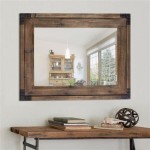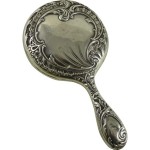How To Hang A Heavy Mirror Securely
Hanging a heavy mirror can dramatically enhance a living space, adding light, depth, and a touch of elegance. However, the weight of such mirrors necessitates careful planning and execution to ensure secure and safe installation. Improper installation can lead to the mirror falling, causing damage to property and potentially risking injury. This article provides a detailed guide on how to hang a heavy mirror, covering the necessary tools, crucial preparation steps, and various hanging methods.
Before commencing the project, it is imperative to understand the inherent risks associated with handling heavy objects. Adequate precautions must be taken to avoid personal injury. This includes wearing appropriate safety gear, such as work gloves and safety glasses, and enlisting assistance from another person to lift and position the mirror.
Assessing the Mirror and Wall
The first step involves a thorough assessment of both the mirror and the wall where it will be hung. Determining the mirror's weight is paramount. This information is typically available on the packaging or can be obtained from the manufacturer or retailer. If the weight is unknown, it is advisable to use a bathroom scale to accurately measure it.
Next, the wall's composition must be identified. Common wall types include drywall, plaster, and concrete. Drywall is the most prevalent in residential construction but offers minimal structural support. Plaster walls, while sturdier than drywall, can be brittle and prone to cracking. Concrete walls, on the other hand, provide the strongest anchoring surface but require specialized tools and techniques.
The presence and location of wall studs are also critical. Wall studs are vertical framing members that provide structural support for the wall. They are typically spaced 16 or 24 inches apart. Hanging a heavy mirror directly on a stud is the most secure method, as the stud can bear a significant amount of weight. A stud finder, either magnetic or electronic, is used to locate the studs behind the wall surface. Magnetic stud finders detect nails or screws embedded in the stud, while electronic stud finders detect changes in density behind the wall.
After locating the studs, mark their positions clearly with a pencil. It is recommended to verify the stud's location by driving a small nail into the wall in the area where the mirror will be hung. If the nail hits solid wood, it confirms the presence of a stud. If the nail encounters no resistance, it indicates that the area is between studs.
Gathering the Necessary Tools and Materials
Successful mirror hanging requires a specific set of tools and materials. The selection depends on the mirror's weight, the wall type, and the chosen hanging method. Essential tools include:
- Measuring tape: To accurately determine the mirror's desired position on the wall.
- Level: To ensure the mirror is hung straight.
- Pencil: To mark the desired location and stud positions.
- Stud finder: To locate wall studs.
- Drill with appropriate drill bits: For drilling pilot holes and installing anchors.
- Screwdriver: To tighten screws.
- Hammer: For tapping in anchors.
- Safety glasses: To protect eyes from debris.
- Work gloves: To improve grip and protect hands.
Necessary materials include:
- Heavy-duty hanging hardware: D-rings, wire, or specialized mirror hanging systems.
- Screws: Appropriate length and gauge for the mirror's hanging hardware and the wall type.
- Wall anchors: If studs are not accessible, anchors suitable for the wall type and mirror weight are required. Types include drywall anchors, toggle bolts, and concrete anchors.
- Picture hanging wire (if using wire): Choose a wire with a weight rating exceeding the mirror's weight.
- Painter's tape: To protect the wall surface and prevent chipping when drilling.
Selecting the appropriate wall anchors is crucial when studs are not accessible. Drywall anchors are designed for use in drywall and come in various types, including self-drilling anchors, plastic anchors, and metal anchors. Toggle bolts are a more robust option for drywall, providing a secure hold by spreading the weight across a larger area behind the wall. Concrete anchors are specifically designed for use in concrete walls and require a masonry drill bit for installation.
When choosing screws, ensure they are of sufficient length to penetrate deeply into the wall stud or anchor. The gauge of the screw should also be appropriate for the hanging hardware to prevent the screw head from passing through the hardware's opening.
Implementing the Hanging Method
Several methods can be employed to hang a heavy mirror, each with its advantages and disadvantages. The choice depends on the factors previously discussed, including the mirror's weight, wall type, and accessibility of wall studs.
Hanging on a Wall Stud: This is the most secure method. After locating a wall stud, mark the desired location for the mirror's top edge. Use a level to ensure the mark is horizontally aligned. Drill a pilot hole through the drywall and into the stud, using a drill bit slightly smaller than the screw's diameter. Attach the mirror's hanging hardware (D-rings or wire) to the back of the mirror, ensuring it is securely fastened. Then, align the mirror with the marked location on the wall and drive a screw through the hanging hardware and into the pilot hole in the stud. It may be necessary to use two screws, especially for wider mirrors, spaced appropriately to distribute the weight evenly.
Using Drywall Anchors: If studs are not accessible, drywall anchors provide an alternative. Select anchors with a weight rating exceeding the mirror's weight, taking into account a safety margin. Follow the manufacturer's instructions for installing the chosen type of anchor. Typically, this involves drilling a hole in the drywall, inserting the anchor, and then driving a screw into the anchor. The screw should be long enough to pass through the hanging hardware and into the anchor firmly. Distribute the anchors evenly across the mirror's width to distribute the weight. Avoid overloading a single anchor, as this can lead to failure.
Employing Toggle Bolts: Toggle bolts offer a stronger hold in drywall compared to standard drywall anchors. To install a toggle bolt, drill a hole large enough to accommodate the toggle wings when they are folded. Thread the bolt through the mirror's hanging hardware and then thread the toggle wings onto the bolt. Fold the wings inward and push them through the hole in the wall. Once the wings are past the wall, they will spring open. Pull the mirror towards the wall, ensuring the wings are firmly against the back of the drywall. Tighten the bolt until the mirror is securely fastened to the wall. Be careful not to overtighten, as this can damage the drywall.
Hanging on Concrete Walls: Hanging a heavy mirror on a concrete wall requires specialized concrete anchors and a masonry drill bit. Mark the desired location for the mirror and drill pilot holes into the concrete using the masonry drill bit. Insert the concrete anchors into the holes and tap them gently with a hammer until they are flush with the wall surface. Attach the mirror's hanging hardware to the back of the mirror and then align the mirror with the anchors. Drive screws through the hanging hardware and into the anchors, tightening them until the mirror is securely fastened to the wall.
After hanging the mirror, it is crucial to verify its stability. Gently push on the mirror to ensure it is securely attached to the wall. If there is any movement or instability, re-evaluate the hanging method and consider using stronger anchors or screws. Do not hesitate to consult with a professional if unsure about the proper installation techniques.
For mirrors using wire, ensure the wire is of appropriate strength and is securely attached to the D-rings on the back. Consider using two D-rings for heavier mirrors to distribute the weight. Position the D-rings equidistant from the mirror's center for balanced support.
Before completely finishing, slightly loosen the weight on the mirror to verify if your hanging method is robust enough. If the mirror sags or the attachment points appear to weaken, upgrade the installation.
Finally, consider adding bumpers to the bottom corners of the mirror. This will reduce wall damage and protect the mirror from potential scratches.

How To Hang A Large Or Heavy Mirror

How To Hang A Heavy Mirror C R F T
How To Hang A 100 Pound Mirror On Drywall Quora

How To Hang A Heavy Mirror With French Cleat

How To Hang A Heavy Mirror Diy Family Handyman

How To Hang A Very Heavy Picture Or Mirror The Best

A Better Way To Hang Heavy Mirror Hanging Pictures

How To Hang A Heavy Mirror Ask This Old House

How To Hang A Heavy Mirror Or Picture True Value

How To Hang A Heavy Mirror On Brick Fireplace Drill Into Dans Le Lakehouse








